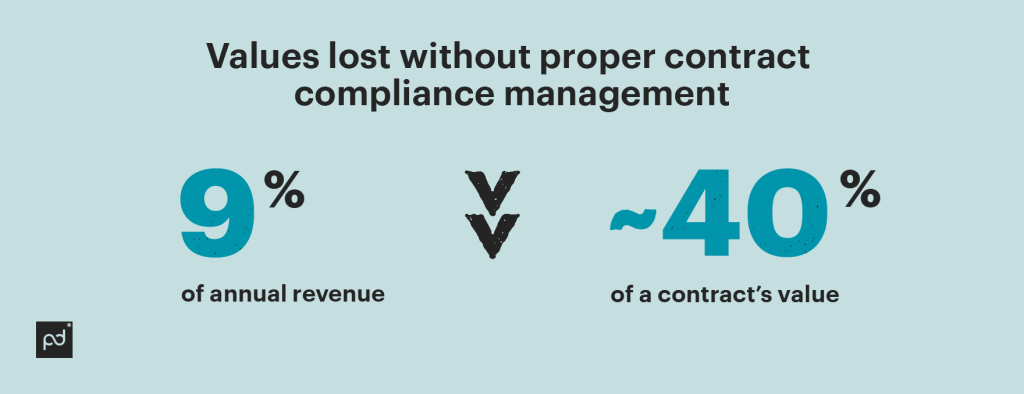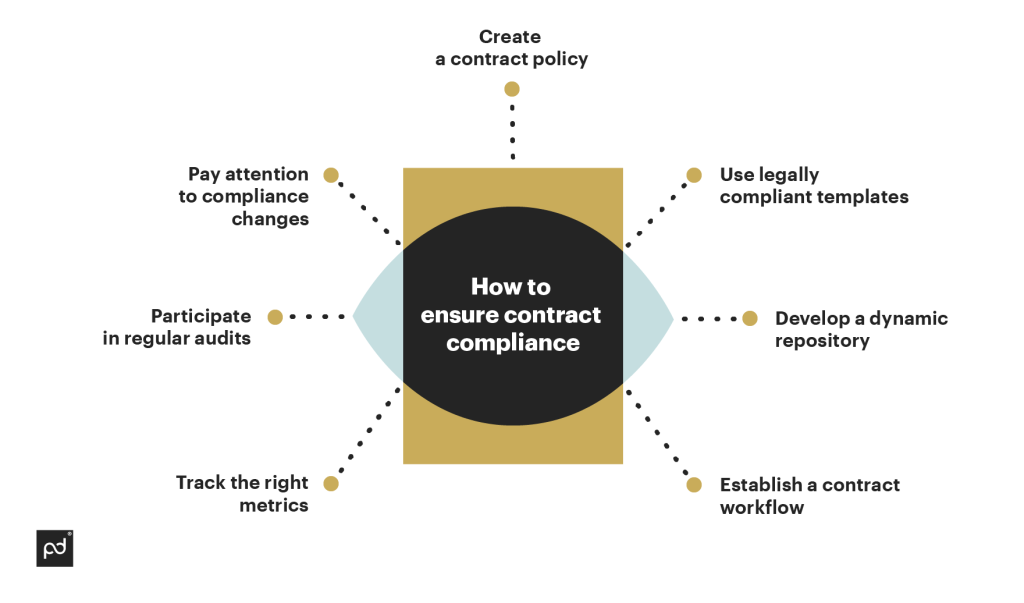Contract compliance can seem difficult, even impossible, without a legal team, but non-compliance could bankrupt you faster than you can say “litigation.”
70-80% of business operations require a written contract, but 9% of annual revenue and about 40% of a contract’s value is lost without proper contract compliance management.

With that said, it’s hard to justify the cost of hiring a contract lawyer for a startup, but how else can they reduce legal risks, prepare for audits, or stay ahead of renewal dates?
Is there really a way to stay legally compliant without it costing $80 an hour?
Yes. Read on to learn more about simplifying the contract management process and maintaining contract compliance throughout your business.
Key takeaways:
- Contract compliance is the process of upholding and honoring the standards of a contract, both in a legal sense and a business sense.
- It is a vital part of any company’s risk management strategy and protects businesses.
- Ensure contract compliance at your business by adopting a few best practices.
- Consider several important factors when choosing software that can help with contract management.
What is contract compliance?
Contract compliance, in a broad sense, is the measurement of how closely a contract complies with the laws and regulations set out by contract law, which is governed by state common law.
In a business sense, contract compliance ensures your business follows external (government law) and internal (business policy) standards.
All contracts have a primary goal the business wants to reach, and complying means a business reaches these goals legally.
Is an agreement a contract?
Although the terms “contract” and “agreement” are used interchangeably, they aren’t the same.
The key difference between a contract and an agreement is an agreement isn’t legally binding and is therefore not subjected to the same laws and compliance as a contract.
However, if the party who issues the agreement says it’s a “contract” when it’s really an agreement (or vice versa), the signed party can’t be expected to follow the agreement or be charged if they break the agreement’s terms.
In these cases, the agreement or contract becomes void, as it was signed under false pretenses.
Always clarify with the party issuing the agreement if the document is really a contract.
Why is contract compliance important?
Contract compliance plays a major role in a company’s risk management strategy and helps to ensure all contract stakeholders stick to the agreement’s terms.
Here’s why contracts are vital.
Contract compliance protects businesses and individuals
Contracts have been used in legal systems since they were first developed.
They serve as a legally binding document that protects both parties involved from changing the stipulations of the agreement without expressed consent from the other party.
If an agreement doesn’t break contract law, it guarantees that the conditions in the agreement will be carried out.
If a party breaches the terms, the parties affected can seek remedies under the law that otherwise wouldn’t be available without a written document.
For example, this freelance contract template states that the parties will attempt to settle any dispute by mutual agreement before going to court.
A well-drafted document can provide plenty of benefits to you and your business, such as:
- The clarity in business relationships and the rights of each party
- Avoiding contractual disputes that could land you in court
- Preventing misinterpretations of roles and responsibilities
- Protecting asset values, physical property, and intellectual property
- The ability to resolve disputes by arbitration, mediation, or a court
On top of all these benefits, ensuring compliance will bring in more business and protect your startup‘s reputation.
Legal disputes don’t just directly affect your wallet.
Contract compliance protects your startup’s reputation
If a document doesn’t follow contract law, it becomes a void document before the agreement is signed.
A court of law will void a contract if you ask to do something impossible or illegal.
However, a contract becomes voidable after it’s signed if a court determines:
- Fraud has taken place
- The parties didn’t disclose a material fact
- The document was signed under duress
- A party was legally incapacitated
- The agreement has unconscionable terms
Suppose your business creates a void or voidable contract, and you attempt to seek damages when a client breaks the agreement.
Since you didn’t follow compliance protocols, the courts won’t rule in your favor. In fact, they’ll likely charge you for drafting an illegal contract.
Once word gets out that you aren’t doing regular contract audits or meeting your contractual obligations, your reputation takes a hit.
Who wants to work with a company that breaks the law?
Contract compliance ensures commodity price compliance
Let’s look at a specific example of how contract compliance benefits your company.
Under a market-oriented economy, price is formed and regulated by the market itself.
Typically, a business must comply with the law of value and must change its price based on readjusted prices.
In some instances, the government may guide prices or set them.
As a business, you can’t price dump (sell products way below market costs), sell commodities at an unfairly high price, or participate in price collusion or manipulation.
Without an active contract compliance process, you could break these laws unintentionally.
For example, steel, a material commonly used in manufacturing, cost 47% more in January 2021 than 1 year earlier.
However, the price of steel can fluctuate by 8% daily.
You could pay a fine if you don’t update your contract to adjust for these market fluctuations.
9 challenges companies face in compliance and contract management strategy
Despite how important a compliance system can be for your company, compliance management is often a lot harder than it needs to be.
Here are a few challenges that prevent compliance.
1. Maintaining contracts that aren’t in writing
Verbal contracts are too risky and won’t hold up well in court. All compliance processes should include written contracts.
2. Contractual review is expensive for teams
Hiring a lawyer every time you need help complying with a legal process is very expensive for startups and small teams.
3. Defining and tracking contract costs
Managing costs and compliance issues regarding contracts is almost impossible with a manual system due to a lack of visibility.
4. Streamlining agreement approval
To meet your contractual obligations, you need an approval process, which can be difficult without automation software.
5. Dealing with outdated legal speak
Legal jargon is an integral part of any compliance system, but if it’s outdated, it could harm you or your customers.
6. Lack of contract version control
All legal documents require a “final version” that includes the most up-to-date regulations and legal processes, or it won’t protect you.
7. Time-consuming legal reviews
Contract compliance isn’t just expensive; it’s also incredibly time-consuming without contract management software.
8. Constantly evolving standards
Companies require legal services because it’s hard to keep up with changing laws. Non-compliance could negatively affect your bottom line.
9. Sending contracts via snail mail
Sending a contract via mail or email is unsafe and could delay the contracting process. It makes the review and sending process inefficient.
While full contract compliance across the entire contract lifecycle can benefit from legal services, it doesn’t necessarily require it.
In fact, you can develop a great contract management workflow separate from a legal team, although it will need new resources.
How to ensure contract compliance
Managing your various contract management processes can be as easy as adopting a few best practices.
Use these tips to help you knock contract compliance out of the park.

1. Create a contract policy
When adopting a new workflow, your employees aren’t going to know how to manage your processes.
A contract playbook can give your employees some much-needed direction on what clauses go where what regulations to fall back on, and what document to use for what purpose.
Legal teams often use contract playbooks to remain consistent, so literally take a page out of their book and document the steps required to achieve total contract compliance.
2. Use legally compliant templates
When you can’t use other professional services to maintain contract compliance, rely on legally-binding templates. That way, you’ll always be up for contract negotiation.
However, it’s a good idea to get a lawyer to perfect your legal documents before you hand them out to customers or clients.
There may be something you missed while drafting the document, and these mistakes can leave you open to compliance issues down the line.
A long, drawn-out process may cause your employees to rush, which may lead to shortcutting.
However, compliant templates can help lower violations and associated risks.
3. Develop a dynamic repository
The contract compliance process significantly benefits from a contract repository because it gives you access to all the information you need in one place.
Without a dynamic repository, you’ll lose control over your updates or document versions, which could get messy quickly.
With the help of a contract management system, you can say goodbye to paper filing and misplaced agreements.
Now, you’ll be able to track your contracts from a single dashboard.
4. Establish a contract workflow
You can authorize contracts faster by adopting a standardized workflow. To do this, you must define hierarchies in the approval process and use the right protocols and procedures.
For example, self-service or self-serve contracts can help departments negotiate contracts and send out agreements for acceptance without significant input from a law firm.
Although they can’t be used for everything, they’re perfect for high-volume, low-risk agreements.
It’s also important to assign duties to your employees.
If you don’t, important tasks could be neglected or completed incorrectly, which won’t make complying any easier.
5. Track the right metrics
The only way to improve your contract compliance and managing processes is to track the right metrics actively. You can use these metrics as a part of your auditing protocol.
Here are a few metrics you should definitely track to improve compliance:
- How many contracts you’ve processed
- Turnaround time
- Response time
- First to final draft
- Dollar value
- Reading simplicity
- Cost per transaction
- Deviations
- Legal obligations
If you have international clients, track your contracts by type, business unit, and geography.
6. Participate in regular audits
Best auditing practices also include creating a database of usable analytics and metrics that you can use to make better legal documents. However, auditing isn’t all about the numbers.
For example, it would be hard to know if a vendor overpaid without staying up-to-date with commodity compliance regulations.
You need hard data and industry knowledge to point out compliance issues regarding cost amortization, volume discounts, and clerical errors.
Once you can put the pieces together, you’ll start seeing these issues more clearly. With this knowledge, you can improve your revenue operations and other policies.
7. Pay attention to compliance changes
It isn’t enough to optimize your contract compliance practices once; you need an ongoing and holistic approach to maintain compliance now and forever.
The regulatory landscape is always shifting, so keeping a watchful eye out for changes will only benefit your company in the end.
For example, women-owned businesses could see up to 64 opportunities regarding consolidated contracts in the United States. Once these changes occur, you need to be ready.
Factors to consider when choosing contract compliance software
Contract compliance software can be a godsend.
It automates contract management processes, streamlining operations and enhancing accuracy. But you’ve got to consider several key factors when choosing a solution.
Functionality and features
Put simply: does it do what you need it to? Your chosen software’s functionality and features need to align with your specific contract compliance needs.
Look for features such as contract creation, tracking, monitoring, and reporting capabilities.
Assess if the software supports complex contract terms, workflows, and integrations with other systems to ensure seamless operations across your organization.
User-friendliness
No one likes software that’s overly complicated or difficult to use.
Go with a provider whose software is intuitive and user-friendly. It will be a lot easier to integrate within your organization if people actually like it.
A user-friendly interface with clear navigation and well-organized features will make rolling out the software a lot easier and increase overall efficiency.
Integration capabilities
In addition to endearing itself to the people in your organization, contract compliance software should also seamlessly integrate with your existing systems.
Your chosen solution should play well with your existing customer relationship management (CRM) software and document management systems.
Integration capabilities enable data synchronization, eliminate duplicate data entry, and improve overall efficiency.
Security and data protection
Contracts often contain sensitive and confidential information.
When looking for contract compliance software, ensure it prioritizes security measures such as data encryption, access controls, and regular backups.
Consider compliance with industry standards such as GDPR or HIPAA, depending on your specific industry and regulatory requirements.
Reporting and analytics
The ability to generate comprehensive reports and analytics is crucial for contract compliance monitoring and analysis.
Look for software that offers robust reporting functionalities, enabling you to track key metrics, identify trends, and gain valuable insights into your contract performance and compliance status.
Customer support and training
Having a piece of software that nobody knows how to use is a little like getting a new toy without the batteries.
Consider the level of customer support and training provided by the software vendor.
Ensure they offer sufficient resources such as documentation, training materials, and responsive customer support to assist you.
Cost and ROI
Evaluate the pricing structure of the software, considering both upfront costs and ongoing maintenance fees.
Assess the return on investment (ROI) potential by considering the time and cost savings, improved compliance, and reduced risks that the software can provide.
Key areas to focus on during a contract compliance audit
Conducting a contract compliance audit allows organizations to identify any deviations from agreed-upon terms, mitigate compliance risks, and optimize contract performance.
When conducting a contract compliance audit, it is essential to focus on specific key areas.
Contractual terms and conditions
Review these thoroughly to ensure that they are being adhered to.
Keep a particular eye on critical provisions such as deliverables, performance metrics, timelines, pricing, payment terms, and dispute resolution mechanisms.
Verify that all parties involved are fulfilling their obligations as outlined.
Financial compliance
Examine financial aspects related to the contract, including invoicing, pricing accuracy, discounts, rebates, and payment terms.
Verify that the financial transactions align with the agreed-upon terms and that there are no discrepancies or unauthorized charges.
Make sure all financial records and supporting documentation are accurate and up to date.
Performance and quality assurance
Assess the performance of the contracted party in delivering goods or services as per the contract requirements.
Monitor key performance indicators (KPIs) to track performance and identify any areas of non-compliance or underperformance.
Regulatory and legal compliance
Ensure that all contractual activities comply with relevant regulatory requirements and legal obligations.
Risk management
This includes identifying and evaluating risks related to financial, operational, legal, and reputational aspects.
It’s crucial to determine if adequate controls and mitigation strategies are in place and whether any potential risks are being addressed appropriately.
Documentation and record keeping
Make sure that all relevant documents, including contracts, amendments, correspondence, and reports, are properly maintained and organized.
Vendor and supplier management
Evaluate the management of vendors and suppliers involved in the contract.
Assess their compliance with contractual terms, their financial stability, and their ability to meet performance requirements.
Internal controls and processes
Assess the effectiveness of procedures related to contract creation, approval, monitoring, and reporting.
Identify any gaps or weaknesses in the internal control framework and implement necessary improvements.
How can I truly ensure contract compliance?
Ensuring contract compliance isn’t easy, even if you follow our best practices to a “T.”
While having a clearly defined contract compliance strategy in place can help you retain clients, avoid unnecessary expenditures, and keep you away from the courtroom, a manual process can’t take full advantage of these benefits.
That’s because you’ll be spending too much time fiddling with individual contracts, paying attention to readily changing external obligations, and then some.
Unless you want to review the legal requirements of your existing contracts daily, you’ll have to do away with time-wasting policies that leave you wide open to human error.
Why you should create a standardized contract management process with software
Here’s why the best-in-class organizations have more than 75% of their contracts in a searchable repository, aka, a contract management system.
Superior contract compliance
When using contract management software, you streamline the process and ensure accountability throughout the workflow.
Since you will conduct your business online, the parties involved can’t delete or edit the document without notifying the contract managers.
Reduced approval times
With software, you can build templates from a pre-approved library of clauses, or you can pick a premade template instead.
Coupled with a customizable automated workflow and a fast review process, you’ll be able to create, send, and sign more contracts in less time.
Automated renewals
At the end of the contract lifecycle, you can set your contracts to renew automatically, provided an automatic renewal is in the contract terms.
You can use software to send out notifications or stop a renewal if doing so would increase legal risk.
For example, if compliance rules change.
Better document management
Document management software keeps all your documents stored in one place, making it easy for your team to find what they need.
You can upload paper documents to the software, manage your contracts on desktop and mobile, and fully automate repetitive tasks.
Increased document visibility
When you switch to contract management software, you get a bird’s-eye view of your workflow.
That means you’ll be able to stay up to date with the latest compliance rules and easily identify areas where contracts can be improved.
You can even assign who can see or sign the agreement.
Improved audit preparation
Regular contract audits and periodic reviews of new contracts can ensure you’re meeting industry standards.
The software can give you access to a complete audit trail, enabling a more standardized process for contract amendments and contract compliance activities.
Boosted completion rates
If your contract completion rate is low, you can increase your ability to capture eSignatures with electronic signature software.
You don’t have to wait for paper documents to appear at your home or risk a data breach when sending a contract over email.
With software, you’re secure.
Final thoughts
Contract compliance is essential. It protects individuals and businesses from legal disputes, angry customers, and incorrectly drafted self-serve contracts.
When you add document management software to the mix, you’ll be able to outline team-based performance obligations, learn from well-crafted contract examples, sign contracts, and input only the most relevant information in your new contracts.
With PandaDoc, you can do all of that and more.
Frequently asked questions
-
Contract compliance monitoring describes the process of examining, observing, and documenting the quality of the contract language used in a legal document.
A company would study the new obligations, regulations, rules, roles, and responsibilities issued by legal entities, such as federal and state governments, and their subsequent laws to measure compliance. They would then use this information and apply it to a new contract.
Companies may collect data from their own analytics software or document management software to create better contract processes that better meet compliance standards.
-
The best way to ensure compliance with a contract is to develop a project workflow and a means to measure compliance, like utilizing contract management software.
It also helps to adopt some best practices, like creating contract templates or monitoring contract performance.
-
Manual contract compliance management is incredibly difficult and time-consuming. The most effective way to do it is by utilizing contract management software that offers the features we cover in the article above. It is also crucial to carry out contract compliance audits on a regular basis.
-
There are many different factors involved in monitoring contract compliance, and these responsibilities fall to a contract compliance specialist or contract manager. They will be the ones to conduct audits and investigations and generally ensure that everything is kept above board.
Disclaimer
PandaDoc is not a law firm, or a substitute for an attorney or law firm. This page is not intended to and does not provide legal advice. Should you have legal questions on the validity of e-signatures or digital signatures and the enforceability thereof, please consult with an attorney or law firm. Use of PandaDocs services are governed by our Terms of Use and Privacy Policy.


